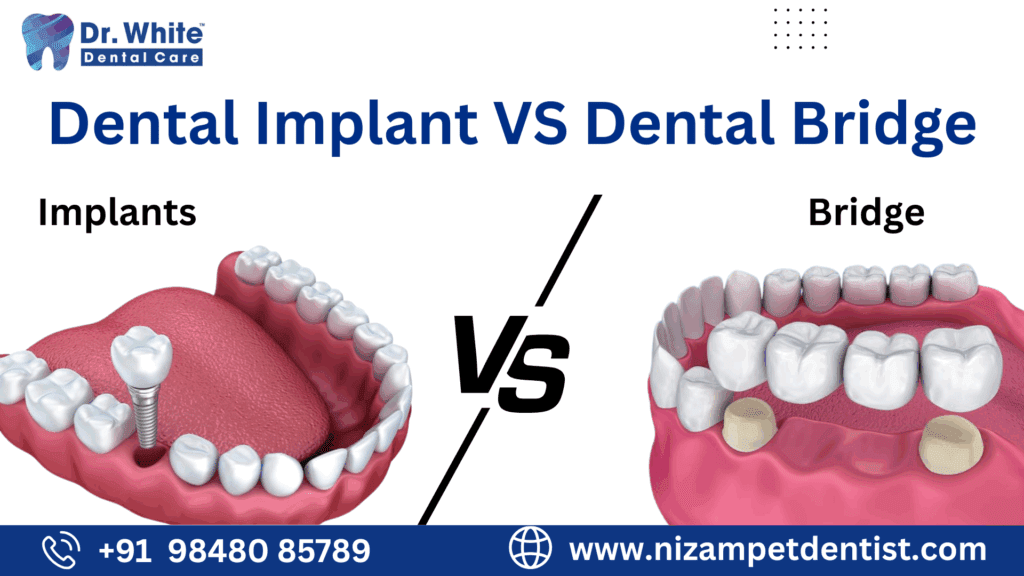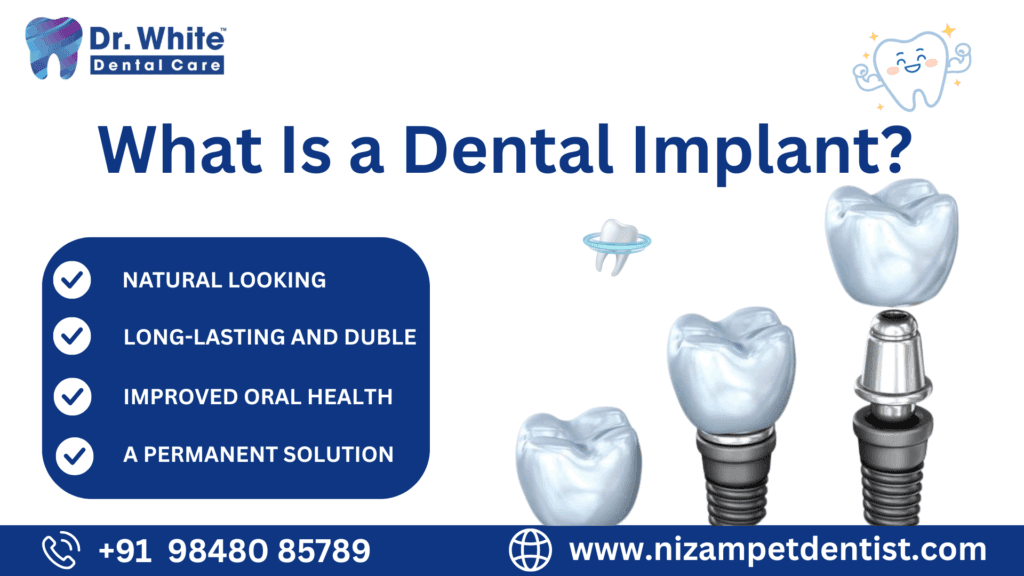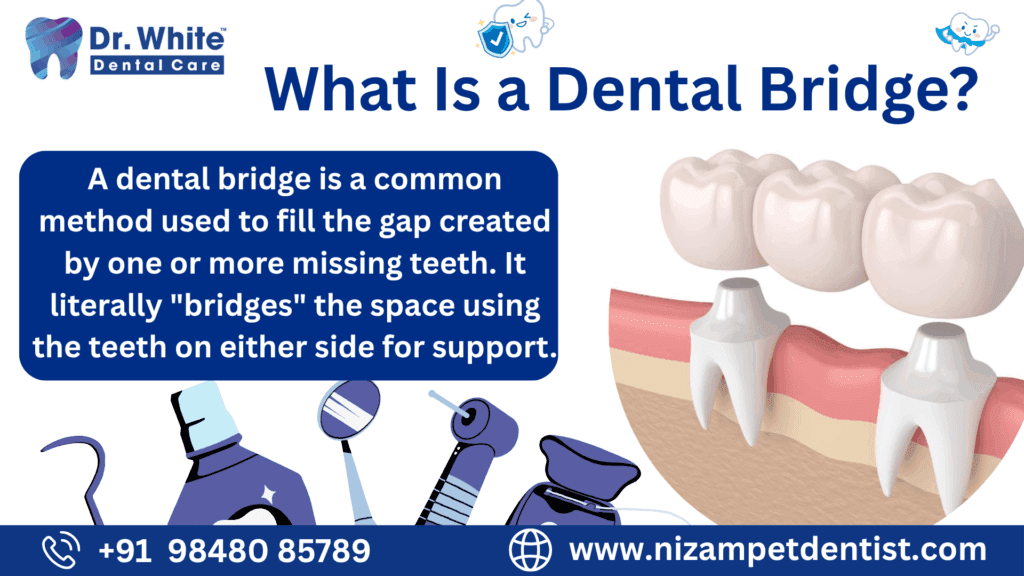Dental Implant VS Dental Bridge

Losing a tooth is more than just a cosmetic issue—it can affect how you speak, chew, and even how confident you feel when you smile. Over time, missing teeth can also lead to bone loss in the jaw, shifting of nearby teeth, and other dental problems if left untreated.
Thankfully, modern dentistry offers two highly effective solutions to replace missing teeth: dental implants and dental bridges. Both options are widely used, but they work in different ways and offer different benefits. While dental implants are fixed directly into the jawbone like a natural tooth root, bridges rely on support from neighboring teeth to fill the gap.
If you’re trying to decide between these two treatments, this blog is here to help. We’ll explain how each option works, compare their pros and cons, and help you understand which one might be the better fit for your smile, lifestyle, and budget.
By the end of this post, you’ll have a clear understanding of the difference between a dental implant and a dental bridge, so you can make an informed decision about your dental health.
2. What Is a Dental Implant?

A dental implant is a modern way to replace a missing tooth. It looks, feels, and works just like a natural tooth. It is fixed into your jawbone and gives long-lasting support for chewing, smiling, and speaking confidently.
Main Parts of a Dental Implant
A dental implant has three main components:
- Implant Post:
A small titanium screw placed into your jawbone. It acts like a natural tooth root and holds everything in place. - Abutment:
A connector piece attached to the top of the implant post. It helps support the crown. - Dental Crown: The visible tooth-like part placed on top. It’s custom-made to match your natural teeth in shape and color.
Basic Steps in the Dental Implant Procedure
- Consultation & X-rays:
Your dentist checks your mouth and takes X-rays or 3D scans to plan the treatment. - Implant Placement:
The titanium post is surgically placed into your jawbone. Local anesthesia is used, so you won’t feel pain. - Healing Time (3–6 months):
The bone grows around the implant post to hold it firmly in place. This process is called osseointegration. - Abutment & Crown Fitting:
Once healing is complete, the abutment and crown are placed. You now have a fully functional and natural-looking tooth!
3. What Is a Dental Bridge?
A dental bridge is a common method used to fill the gap created by one or more missing teeth. It literally “bridges” the space using the teeth on either side for support.

What Is a Dental Bridge?
- A dental bridge is made up of two or more crowns (called abutments) that go over the healthy teeth on either side of the gap.
- Between them, a false tooth (called a pontic) fills the empty space.
- The bridge is cemented in place and is not removable like dentures.
Types of Dental Bridges
- Traditional Bridge:
Most common type. Uses crowns on both sides of the gap to hold the false tooth in between. - Cantilever Bridge:
Used when there’s only one tooth next to the missing space for support. - Maryland Bridge:
Uses a metal or ceramic wing bonded to the back of nearby teeth—requires less drilling. - Implant-Supported Bridge: Uses dental implants instead of natural teeth to hold the bridge. Ideal for multiple missing teeth.
How Is a Dental Bridge Done?
- Tooth Preparation:
The nearby teeth (abutments) are trimmed slightly to fit the crowns. - Impressions Taken:
Your dentist takes a mold of your teeth to create a custom bridge that fits perfectly. - Bridge Fitting:
The bridge is placed and adjusted for bite and comfort. Then it’s cemented permanently.
Feature | Dental Implant | Dental Bridge |
Appearance | Looks and feels just like a natural tooth. | Also looks natural but may show slight gaps over time. |
Longevity | Can last 15 to 25+ years, sometimes even a lifetime with good care. | Usually lasts 7 to 10 years; may need replacement sooner. |
Comfort | Very comfortable; feels like your own tooth. | Comfortable but may feel slightly different over time. |
Jawbone Preservation | Helps keep your jawbone strong and healthy. | Does not support the jawbone; bone loss may occur over time. |
Cost | Higher upfront cost, but more cost-effective in the long run. | Lower initial cost, but may need more maintenance or replacement. |
Procedure Duration | Takes more time (3–6 months including healing). | Faster treatment (usually 2–3 weeks). |
Age Suitability | Best for adults with strong jawbones. | Suitable for most age groups, especially older adults. |
Effect on Nearby Teeth | Doesn’t affect other teeth—placed directly into the jaw. | Nearby teeth need to be trimmed to support the bridge. |
Maintenance Requirements | Easy to maintain—brush and floss like natural teeth. | Needs extra care—cleaning under the bridge requires special tools. |
5. Longevity and Durability
When choosing between a dental implant and a dental bridge, it’s important to know how long each option lasts and what affects their durability.
How Long Do Dental Implants Last?
- Dental implants are made from strong materials like titanium and ceramic.
- With proper care, they can last 15 to 25 years or even a lifetime.
- Most people don’t need to replace them unless there’s an issue like bone loss or gum disease.
How Long Do Dental Bridges Last?
- Dental bridges usually last between 7 to 10 years.
- With excellent dental hygiene and regular checkups, they can sometimes last up to 12–15 years.
- Bridges may need replacement if the supporting teeth (abutments) get weak or decayed.
What Affects Their Lifespan?
- Oral hygiene: Brushing twice a day, flossing, and regular dental cleanings keep both options in good shape.
- Habits: Avoiding smoking, chewing hard objects, or grinding your teeth can extend the life of implants and bridges.
- Material quality: Higher-quality crowns and bridges (porcelain or zirconia) last longer and look more natural.
- Dentist’s skill: Proper placement and bite alignment by an experienced dentist make a big difference.
6. Bone Health and Structural Support
When you lose a tooth, it’s not just the gap you need to worry about—your jawbone can also weaken over time. Let’s see how dental implants and bridges affect your bone health and facial structure.
How Dental Implants Support Bone Health
- Dental implants act like natural tooth roots.
- When placed into the jawbone, they stimulate the bone every time you chew or bite.
- This keeps the bone strong and helps prevent bone loss (also called bone resorption).
- Implants also help maintain the natural shape of your face, especially around the cheeks and jaw.
How Dental Bridges Affect Bone Health
- Dental bridges sit on top of the gums and do not go into the jawbone.
- Because there’s no stimulation to the bone underneath, the bone in that area may shrink slowly over time.
- This can eventually lead to changes in facial shape, such as a sunken appearance in the jaw or cheeks.
Who Should Think About Bone Preservation?
- People who are younger or planning for long-term results
- Those who have recently lost a tooth and want to prevent future bone loss
- Anyone who cares about maintaining their facial shape and jaw strength over time.
7. Comfort and Functionality
When choosing between a dental implant and a dental bridge, how they feel and function in daily life is just as important as how they look. Here’s how both compare in terms of comfort and use.
How Comfortable Do They Feel?
- Dental implants are fixed into your jawbone, just like real teeth.
- Once healed, they feel completely natural—you might forget it’s even there.
- Implants don’t shift or move while talking or eating.
- Dental bridges rest on nearby teeth and gums.
- They may feel slightly different or less natural over time, especially if nearby teeth become weak or sensitive.
- Bridges can sometimes trap food underneath, which may feel uncomfortable.
Chewing and Bite Strength
- Dental implants offer strong bite force and let you chew most foods normally.
- They’re ideal for people who want to eat without restrictions.
- Bridges offer decent chewing strength but may not be as strong as implants.
- Very hard or sticky foods should be avoided to protect the bridge.
Speech Clarity
- Dental implants rarely affect speech. Most people speak clearly without any adjustment.
- Bridges may slightly affect speech at first, but most adjust quickly.
8. Impact on Adjacent Teeth
One of the important things to consider when choosing between a dental implant and a dental bridge is how the treatment affects the nearby natural teeth. Let’s break it down.
Dental Implants – No Effect on Nearby Teeth
- Dental implants are placed directly into the jawbone.
- They do not touch or rely on the teeth next to them for support.
- Your healthy teeth stay untouched and strong, which is a big advantage for long-term dental health.
- This helps preserve your natural tooth structure and reduces the risk of future dental issues.
Dental Bridges – Involves Adjacent Teeth
- Dental bridges need support from the teeth on either side of the missing tooth.
- To place the bridge, the dentist has to trim or shave down these healthy teeth to fit crowns over them.
- Over time, these supporting teeth may become weaker or more prone to decay, especially if not cleaned properly.
- If one of these teeth is damaged later, the entire bridge might need to be replaced.
9. Procedure Timeline and Recovery
When deciding between a dental implant and a dental bridge, one big factor is how long the treatment takes and how quickly you can recover. Here’s a clear comparison:
Dental Implant – Multi-Stage Process
- Consultation & Planning:
Your dentist checks your teeth, takes X-rays or 3D scans, and creates a treatment plan. - Implant Surgery:
The implant (a small titanium post) is placed into the jawbone. Local anesthesia is used, so the process is comfortable. - Healing Time (Osseointegration):
The implant needs 3 to 6 months to fuse with the bone and become strong enough to hold a crown. - Abutment & Crown Placement:
After healing, the abutment and final crown are fitted. You now have a tooth that looks and works like a real one.
Dental Bridge – Faster Process
- Consultation & Planning:
Your dentist checks your teeth, takes X-rays or 3D scans, and creates a treatment plan. - Implant Surgery:
The implant (a small titanium post) is placed into the jawbone. Local anesthesia is used, so the process is comfortable. - Healing Time (Osseointegration):
The implant needs 3 to 6 months to fuse with the bone and become strong enough to hold a crown. - Abutment & Crown Placement:
After healing, the abutment and final crown are fitted. You now have a tooth that looks and works like a real one.
Which Is Better for You?
- Choose a dental bridge if you need faster results or are preparing for an event like a wedding or interview.
- Choose a dental implant if you prefer a long-term, permanent solution that supports bone health and durability.
10. Cost Comparison in India
Here’s a simple cost comparison of dental implants vs dental bridges in India to help you understand which option suits your budget and long-term goals.
Dental Implant – Cost & Details
- Average Cost in India: ₹25,000 to ₹60,000+ per implant
- Additional Costs:
- Bone grafting (if needed): ₹5,000 to ₹20,000
- 3D scans & consultations
- Bone grafting (if needed): ₹5,000 to ₹20,000
- Long-Term Value:
- Lasts 15–25 years or more
- Less maintenance required over time
- Lasts 15–25 years or more
- Best for: Patients looking for a long-lasting, permanent solution
Dental Bridge – Cost & Details
- Average Cost in India: ₹10,000 to ₹30,000 depending on the number of teeth
- Additional Costs:
- Possible replacement after 7–10 years
- Repairs if supporting teeth are damaged
- Possible replacement after 7–10 years
- Maintenance Needs:
- Extra care while brushing and flossing
- May need replacement sooner than implants
- Extra care while brushing and flossing
- Best for: Patients who want a faster and budget-friendly option
11. When to Choose a Dental Implant
A dental implant is one of the most advanced and long-lasting ways to replace a missing tooth. But it’s not the best choice for everyone. Let’s look at when implants are a good option—and when they might not be.
- You’ve lost one or more teeth:
Implants can replace a single tooth or even multiple missing teeth without affecting nearby teeth. - You have a strong, healthy jawbone:
A good amount of bone is needed to support the implant. Your dentist may take an X-ray or scan to check this. - You want a long-term solution:
Implants can last 15–25 years or more with proper care, making them a great investment for the future. - You value natural look and feel:
Implants look, feel, and function just like your original teeth.
12. When to Choose a Dental Bridge
A dental bridge is a common and affordable solution to replace one or more missing teeth. While it may not last as long as a dental implant, it can still be a great choice in many situations.
Ideal Situations for Choosing a Dental Bridge
- You want a faster result:
A dental bridge can usually be completed in just 2 to 3 weeks, which is much quicker than an implant. - You are looking for a budget-friendly option:
Bridges are generally more affordable than implants, especially if you need to replace several teeth. - Implants aren’t possible in your case:
If you have a weak jawbone, medical conditions, or don’t want surgery, a bridge can be a practical alternative. - You already have crowns on nearby teeth:
If those teeth need crowns anyway, a bridge might make more sense.
We are here
Enquire Now
FAQ'S
- Implants last longer and protect your jawbone.
- Bridges are quicker and more affordable in the short term.
- The best choice depends on your bone health, budget, and dental goals.
- Yes, implants can last 15 to 25+ years with good care.
- Bridges usually last 7 to 10 years, sometimes longer with maintenance.
- Implants are often seen as a more permanent solution.
- Nearby healthy teeth need to be trimmed for support.
- May not last as long as implants.
- Doesn’t stop bone loss in the jaw under the missing tooth.
- The procedure is done with local anesthesia, so you won’t feel pain during surgery.
- Mild soreness or swelling is normal for a few days after.
- Most people say it’s less painful than a tooth extraction.
- In India, a single implant usually costs ₹25,000 to ₹60,000+.
- Extra charges may apply for scans, bone grafts, or premium crowns.
- Many clinics offer EMI or payment plans.
- Yes, but start with soft foods for the first few days.
- Avoid very hot, spicy, or crunchy food during healing.
- Once fully healed, you can eat almost anything.
- Avoid hard foods like ice or nuts right after surgery.
- Skip sticky candies and chewing gum during healing.
- Once healed, you can eat most foods, but chew carefully.
- The surgery itself takes about 1 to 2 hours per implant.
- Most patients go home the same day.
- Healing and crown placement take a few months.
- In some cases, yes—called immediate implants.
- Not everyone is eligible; it depends on bone health and tooth condition.
- Your dentist will decide if it’s safe and suitable for you.
- Mild swelling, pain, or bruising may occur after surgery.
- Rare risks include infection, nerve damage, or implant failure.
- Choosing an experienced dentist reduces most risks.
Yes, both options help you chew food comfortably.
Implants feel more natural and offer better bite strength.
Bridges may need care with hard or sticky foods.
Implants take 3 to 6 months to heal fully.
Bridges usually heal in a few days to a week.
Implants are more durable but require more healing time.
Implants cost more at first but last a lifetime.
Bridges are cheaper but may need replacement in 10–15 years.
Implants save more money over time.
Bridges are quicker and easier for older patients.
Implants are better if bone health is good.
Choice depends on health, time, and budget.
Implants are brushed like normal teeth.
Bridges need cleaning under the false tooth.
Use floss threaders or special brushes for bridges.
